Difference between revisions of "Dye transfer from leather"
| Line 40: | Line 40: | ||
''Discolouration from bright coloured sandals bought for 10 euros. A quick rub test with a lightly damp cloth disclosed the issue immediately (06/13).''<br></p> | ''Discolouration from bright coloured sandals bought for 10 euros. A quick rub test with a lightly damp cloth disclosed the issue immediately (06/13).''<br></p> | ||
<p> </p> | <p> </p> | ||
| − | |||
Minimal discolouration may occur with new leathers, however, strong discolouration and discolouration from contact with other materials are not acceptable. The colour fixation is determined in [[leather quality|laboratories]] over [[Rub fastness of leather|rubbing tests]]. There is a simple test anyone can do. Take a white cloth and rub it 10 times dry and 10 times with a damp rag over the marking area. Are there any visible discolourations when rubbing dry, then the leather has strong disclouration. Slight discolourations when rubbing wet can be accepted. Make the same test with comparable leather objects. When the resulting discolouration is too strong, the [[leather quality|quality]] of the leather is not good enough. | Minimal discolouration may occur with new leathers, however, strong discolouration and discolouration from contact with other materials are not acceptable. The colour fixation is determined in [[leather quality|laboratories]] over [[Rub fastness of leather|rubbing tests]]. There is a simple test anyone can do. Take a white cloth and rub it 10 times dry and 10 times with a damp rag over the marking area. Are there any visible discolourations when rubbing dry, then the leather has strong disclouration. Slight discolourations when rubbing wet can be accepted. Make the same test with comparable leather objects. When the resulting discolouration is too strong, the [[leather quality|quality]] of the leather is not good enough. | ||
| Line 53: | Line 52: | ||
<p> </p> | <p> </p> | ||
| − | |||
| − | In | + | With very severe discolouration, you should try to return the items to the shop. Show them the test results. In difficult cases seek help from a consumer advisor or lawyer. Frequently the manufacturer recommends using hairspray, [[Waterproofing leather|waterproofing]] or vinegar to fix the colour, but this don’t always work, and it's not your job to do this. Leave that to the seller of the goods. Most of the trade take leather items back if the discolouration is significant. |
| + | |||
| + | In cases where a complaint or return is not possible, you must seek advice from a [[Leather repair#Leather repair shops|leather specialist]]. But not every case is retrievable. | ||
| Line 63: | Line 63: | ||
</p> | </p> | ||
<p align=center> | <p align=center> | ||
| − | '' | + | ''Markings on [[car leather|car seat leather]] from [[leather belt|leather belts]].''<br></p> |
<p> </p> | <p> </p> | ||
| Line 71: | Line 71: | ||
</p> | </p> | ||
<p align=center> | <p align=center> | ||
| − | '' | + | ''Marks left by the back of a [[Hide - Skin|fur]] blanket on [[leather furniture]].''<br></p> |
<p> </p> | <p> </p> | ||
| Line 78: | Line 78: | ||
</p> | </p> | ||
<p align=center> | <p align=center> | ||
| − | + | ''Discoloration of leather and [[Colour separation of leather|color separation on leather]].''<br></p> | |
| Line 84: | Line 84: | ||
| − | == | + | ==Extreme cases== |
| − | + | A customer bought a medium-priced [[leather jackets|leather jacket]]. When appying [[leather care]] she noticed that the jacket was partially stained. On closer inspection, it turned out that the white [[sheepskin]] was first sewn together and then dyed grey. The colour corrections were done by the manufacturer in a [[leather colour|colour]] that wasn’t an exact match, leaving it patchy. To make matters worse, the dye dissolves slightly when rubbed with a damp cloth. | |
| Line 97: | Line 97: | ||
</p> | </p> | ||
<p align=center> | <p align=center> | ||
| − | '' | + | ''Extreme case: This [[sheepskin|sheep leather]] jacket was first sewn and then dyed. Possibly incorrectly produced and then reworked manually with [[leather colour|leather dye]]. The subsequent corrections are carried out with a not matching leather colour.''<br></p> |
<p> </p> | <p> </p> | ||
| Line 103: | Line 103: | ||
* [[Loose leather fluff]] | * [[Loose leather fluff]] | ||
* [[Colour separation of leather]] | * [[Colour separation of leather]] | ||
| − | * [[ | + | * [[Colour migration]] |
| − | * [[ | + | * [[Leather damages#Dye transfer on leather|Dye transfer by clothing on leather]] |
| − | [[bild: | + | [[bild:Colourlock-02.jpg|16px]] -> [https://www.colourlock.com/tip/furniture/jeans.html Help with staining of jeans on smooth leather] |
<br> | <br> | ||
| − | * [[ | + | * [[Leather damages|Typical leather damages such as aging, fading, grease stains, discolouration etc.]] |
| − | + | ||
<br> | <br> | ||
| − | * [[ | + | * [[Natural markings on leather]] |
| − | * [[ | + | * [[Leather defects]] |
| − | * [[ | + | * [[Leather quality]] |
| − | < | + | <logoplustext /> |
| − | + | ||
| − | + | ||
| − | + | ||
| − | + | ||
| − | + | ||
[[Kategorie:All Articles]] | [[Kategorie:All Articles]] | ||
[[Kategorie:Leather care]] | [[Kategorie:Leather care]] | ||
Revision as of 15:29, 23 October 2016
It sometimes happens that leather garments (jackets, trousers, gloves, belts, bags, shoes) dyes discolour onto other materials. Sometimes it's just fluff from suede or nubuck, but sometimes the dyes have not been sufficiently fixed to the leather.
The surfaces of suede or nubuck is sanded in the manufacturing process. The resulting abrasive dust cannot be completely removed. Rubbing with a light cloth over suede or nubuck will always have a slight discolouration caused by loose leather fluff. But that is usually significantly less than the colour released by leather dyes.
Pull-Up leather and other oiled or waxed leathers are often treated with a tinted wax like shoe polish. Such leathers therefore always discolours slightly. Particularly when warm (which makes waxes and fats liquid) and humidity cause stronger discolouration. This is not not a big issue with shoes as they do not often come into contact with sensitive surfaces, but it often occurs with oiled and waxed bag and furniture leather.
Strong discolouring leash.
A leather shoe with colour that rubs off inside. - A leather jacket discolouring on the outer surface.
It is common to find belts which discolour on car leather interiors or leather jackets that discolour on furniture leather or leather bags which transfer colour onto the clothes they come in contact with, and the inside of leather shoes can leave colourful socks.
Discolouration from bright coloured sandals bought for 10 euros. A quick rub test with a lightly damp cloth disclosed the issue immediately (06/13).
Minimal discolouration may occur with new leathers, however, strong discolouration and discolouration from contact with other materials are not acceptable. The colour fixation is determined in laboratories over rubbing tests. There is a simple test anyone can do. Take a white cloth and rub it 10 times dry and 10 times with a damp rag over the marking area. Are there any visible discolourations when rubbing dry, then the leather has strong disclouration. Slight discolourations when rubbing wet can be accepted. Make the same test with comparable leather objects. When the resulting discolouration is too strong, the quality of the leather is not good enough.
Strong colour bleeding from a blue suede jacket during the cleaning process.
With very severe discolouration, you should try to return the items to the shop. Show them the test results. In difficult cases seek help from a consumer advisor or lawyer. Frequently the manufacturer recommends using hairspray, waterproofing or vinegar to fix the colour, but this don’t always work, and it's not your job to do this. Leave that to the seller of the goods. Most of the trade take leather items back if the discolouration is significant.
In cases where a complaint or return is not possible, you must seek advice from a leather specialist. But not every case is retrievable.
Markings on car seat leather from leather belts.
Marks left by the back of a fur blanket on leather furniture.
Discoloration of leather and color separation on leather.
Extreme cases
A customer bought a medium-priced leather jacket. When appying leather care she noticed that the jacket was partially stained. On closer inspection, it turned out that the white sheepskin was first sewn together and then dyed grey. The colour corrections were done by the manufacturer in a colour that wasn’t an exact match, leaving it patchy. To make matters worse, the dye dissolves slightly when rubbed with a damp cloth.
Extreme case: This sheep leather jacket was first sewn and then dyed. Possibly incorrectly produced and then reworked manually with leather dye. The subsequent corrections are carried out with a not matching leather colour.
Additional information
- Loose leather fluff
- Colour separation of leather
- Colour migration
- Dye transfer by clothing on leather
![]() -> Help with staining of jeans on smooth leather
-> Help with staining of jeans on smooth leather







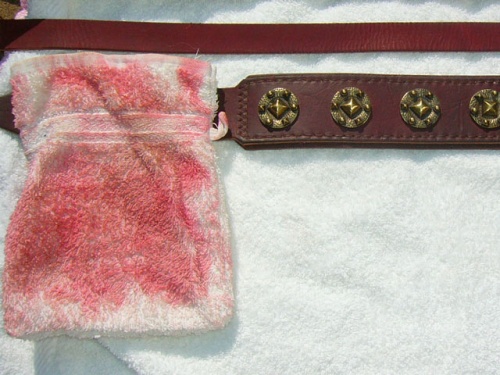
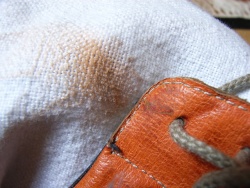
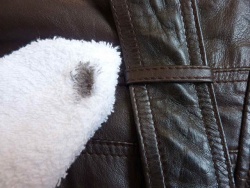
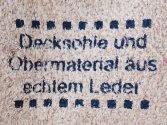
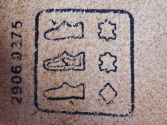
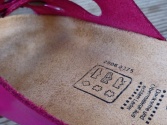
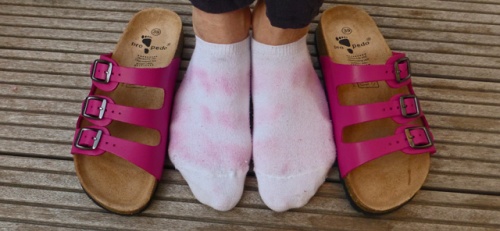
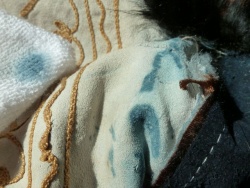
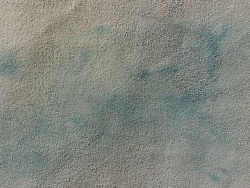
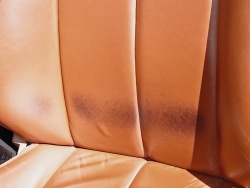
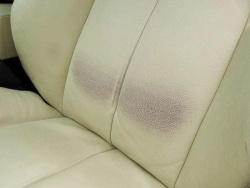
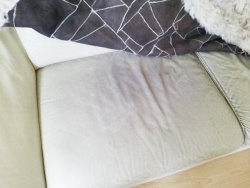
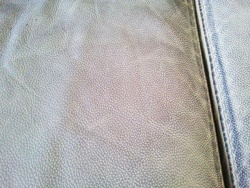
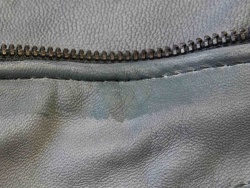
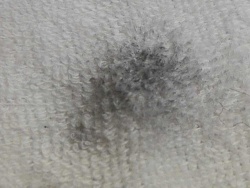
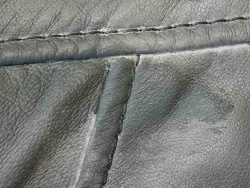
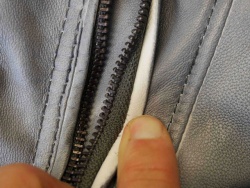

 a kotori web solution
a kotori web solution